Whitewashing: selection and application

One of the most inexpensive and easy-to-use materials for finishing the ceiling is whitewashing. Whitewashing the surface will not be particularly difficult, and you can cope with such a task on your own, without involving masters. In order to get a high-quality coating as a result of the work, you need to know some of the subtleties of working with such a material.


Features and types
Whitewashing is a solution of a specific substance that is used to whiten a surface. Chalk or lime is mainly used as a basis for such a solution. Most often, this material is used in repair work for finishing the ceiling. There is also a kind of medicinal whitewashing for garden plants. Another term "whitewashing" refers to the very process of finishing work.


As noted earlier, lime, chalk, and also water-based paint are used to whiten the ceiling. Each material has its own advantages and disadvantages, as well as differences in finishing work.


chalk
Bleaching the ceiling with a chalk-based solution is one of the cheapest ways to finish ceilings, since the price of chalk is quite low. However, the low price does not mean the poor quality of the material. The chalk mixture is easy to apply and adheres well to the surface. In addition, the mixture has excellent hiding power.
Chalk gets very dirty, which is a disadvantage of this material. This coating has one more disadvantage - the material may turn yellow. To prevent the appearance of a yellowish tint, when making the solution, you need to add a little blue dye to dye fabrics.

Lime
Lime is produced by calcining carbonate rocks. The material has bactericidal properties. Lime mortar bridges fine cracks on the surface well. Such a mixture, like chalk, has a low price.
Lime mortar has a pungent unpleasant odor, which is a disadvantage of such a composition. Finishing work must be carried out with gloves, as in contact with the skin, lime can corrode it.


Water emulsion
Finishing with water-based paint is more expensive than using lime or chalk. Despite this, this type of whitewashing is the most optimal option. Paintwork is more convenient to use and is sold ready for application, in contrast to dry mixes, from which it is necessary to make a solution.
The covering ability of water-based paints is significantly higher than that of chalk and lime mortars. The paintwork material is odorless and adheres well to the surface. On the construction market, you can find water-based waterproof paint, which will allow you to use it for work in wet rooms.


Surface preparation
Before finishing work, special attention should be paid to surface preparation. Without going through this stage, it will not be possible to get a high-quality coating: the whitewash will not fit well, and after a while it may crumble.
If there is no old topcoat on the ceiling, then you just need to wash off the dirt and dust from the surface.It is advisable to putty the plastered surface before applying the whitewash, since the plaster has a granular structure, and the topcoat may turn out to be uneven.


Plaster is also used to repair surface defects and leveling the ceiling. After plastering on the surface, it is necessary to walk well with sandpaper to form an even and smooth coating.


If the base has previously been whitewashed, the previous layer of material must be removed. The surface cleaning process is as follows:
- Furniture and appliances must be removed from the room. Remaining items as well as floors must be protected from dirt. This will require plastic wrap and masking tape.
- To clean the surface, you will need a solution of water and soap, a foam sponge or brush, a metal spatula and a paint bath.
- A small section of the ceiling is moistened with soapy water. The soaked whitewash is removed with a metal spatula, substituting a paint bath so that pieces of material do not fall on the floor.
- Anything that could not be removed with a spatula is washed off with a damp foam sponge.


How to dilute and what is glue for?
The water-based mixture is sold in stores ready for application. If necessary, the paint can be diluted with clean water to obtain the desired consistency. Compositions based on chalk and lime must be prepared independently immediately before finishing work. The solution preparation technology depends on its main component.


Chalk solution
To prepare chalk whitewash, you will need warm water, an adhesive mixture, blue paint for tinting fabric (blue) and the chalk itself. The process of making a solution is as follows:
- in a five-liter bucket of warm water, it is necessary to dilute PVA or wallpaper glue in the amount of thirty grams;
- a small piece of laundry soap (50 grams) is rubbed on a coarse grater and added to the water mixed with glue;
- chalk in the amount of three kilograms must be sieved to remove debris;
- chalk is slowly poured into the water, constantly stirring the solution to avoid the formation of lumps;
- so that the coating turns out to be snow-white and does not turn yellow over time, about twenty grams of blue should be introduced into the solution.

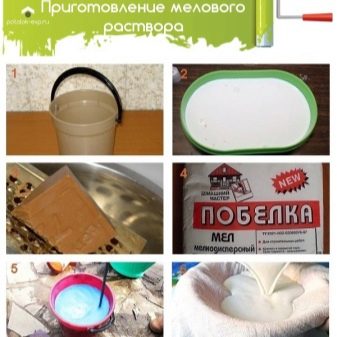
The resulting mixture should be enough to cover one layer of ten square meters of the surface.
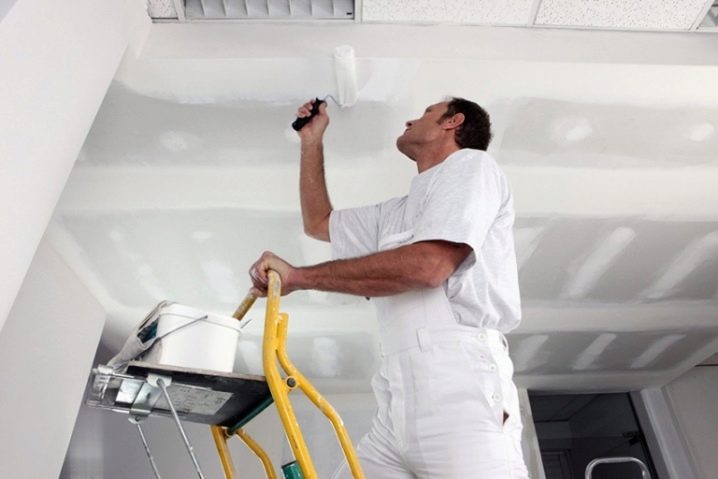
Mortar
In order to prepare a lime solution for whitening with your own hands, you will need slaked lime. This material is produced in the form of a powder mixture or paste. To prepare a solution for 10 m2 of surface, you will need:
- 1.7 kilograms of dry lime;
- 5 liters of water;
- 40 grams of blue fabric dye.


If you want to get a colored rather than a white mixture, you need to add a little dye to the solution. The amount of water used to prepare the whitewash can be less or more than five liters. It all depends on how viscous the solution is. In order to get the desired consistency, you can test the mixture as follows:
- The knife blade must be dipped in the solution.
- Then the knife is slowly removed. If the mixture easily and completely drains off the blade, then the solution is not thick enough and more lime must be added to it.
- A solution of the correct consistency, when in contact with metal objects, should paint them white.

Some Recommendations
To improve the performance of the manufactured bleaching solution, it is necessary to add some additional components to the mixture: wallpaper glue or laundry soap. Instead of wallpaper glue or PVA, you can add joiner's glue mixture to the composition, which you can make yourself at home. Such material is added to the solution in order to improve the quality of the coating and increase its service life.
If lime whitewash will be used for finishing the facade, then drying oil must be added to the solution. The varnish will improve the quality of the coating, making it more reliable and resistant to moisture.


Whitewashed walls are susceptible to various stains. To prevent the coating from being so easily soiled, ordinary edible salt must be added to the whitewash solution. When adding additional components to the mixture, the correct proportions must be observed:
- drying oil is added in an amount of one hundred milliliters per bucket of whitewash solution;
- to obtain a perfectly white lime coating, one kilogram of salt must be taken for ten liters of mortar.

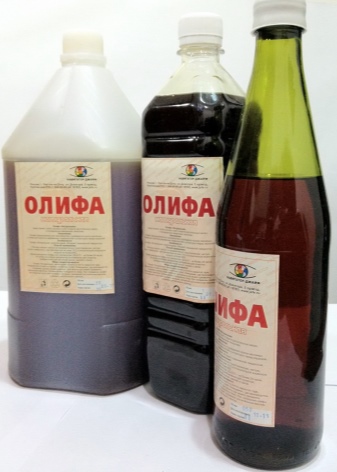
Tools and Consumption
There are several ways to whitewash the ceiling in an apartment. The difference between whitening methods, first of all, lies in the tools used. For finishing work the following accessories may be needed:
- paint brush;
- roller;
- manual spray gun KRDP-3;
- container for solution preparation;
- construction mixer for mixing the mixture;
- ladder;

- brush for cleaning the surface;
- bucket of soapy water:
- masking tape and polyethylene;
- plastic cuvette;
- metal spatula;
- sandpaper.
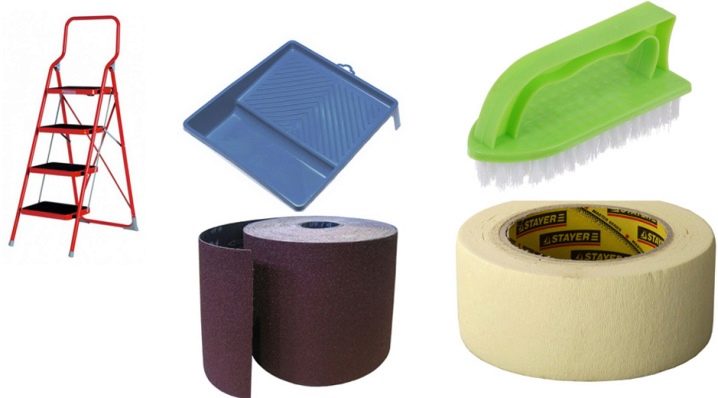
To apply the mixture to the ceiling, a roller or paint brush is mainly used. To prevent a new brush from crumbling during bleaching, it must be soaked for a while in hot water. Initially, it is better to choose a tool with natural hard bristles.
Whitening with a spray gun is a very laborious process. Such a device is more convenient to use for whitewashing walls than ceilings. Before working with such a tool, a ready-made solution of chalk or slaked lime must be passed through cheesecloth.


When preparing the mixture, it should be remembered that the rate of the finished solution per square meter of surface is approximately 0.5 liters. However, the consumption of chalk per 1m2 exceeds the consumption of lime by 1m2. For the manufacture of the solution, it is customary to take the number of components at the rate of consumption per ten square meters.
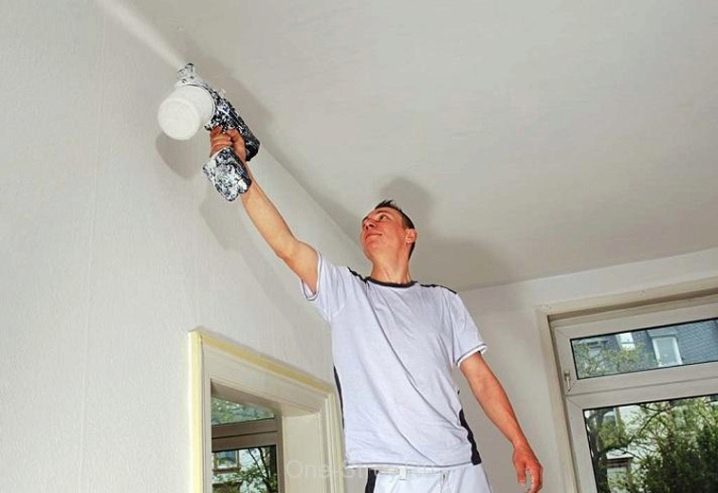
Work order
If the surface was leveled and well washed before finishing work, it will be enough to apply whitewash in only two layers. The ceiling must be mentally divided into small sections. Whitewashing should be started from the corner of the room, it will be more convenient to move from window to door. Before applying each subsequent layer of material, you need to wait until the previous layer dries.


It is best to use a paintbrush to whiten the joints of the ceiling and walls. It is more convenient to cover the rest of the surface with whitewash using a roller. Do not dip the roller too hard into the paint cuvette, as excess mixture on the instrument can lead to smudges and streaks. The mortar is applied to the ceiling with neat parallel strokes.
One layer is not enough to create a high-quality coating. The first layer can show through the shade of the surface, as well as have streaks from the roller. The finishing layer is applied perpendicular to the previous one. Do not forget to regularly stir the solution, as chalk or lime particles can settle to the bottom of the container.


Water-based paint is easier to apply and spreads more evenly. Water-based emulsion can also be used to apply whitewash on an old coat without first cleaning the surface.

Advice
Before buying a material for whitening the ceiling, you must calculate the approximate amount of solution that will be required for finishing. To do this, you need to take into account the area of the surface to be treated and the consumption of a particular composition per square meter. It is advisable to buy material with a margin.
When buying a mixture, pay attention not only to the manufacturer and characteristics of the product, but also to its expiration date. Expired material loses its performance and is not suitable for creating a reliable coating.


During the repair work, as well as when the surface dries, there should be no drafts in the room. Otherwise, the chalk or lime-based coating may peel off.
Before you start whitening the ceiling, you need to take some precautions. The head, eyes and hands should be protected from accidental ingress of the solution, therefore it is recommended to carry out work with gloves, construction glasses and a headdress. To protect the respiratory tract, you must use a respirator or cloth bandage.
Do-it-yourself whitewashing of the ceiling with water-based paint, see the video below.






The comment was sent successfully.